First I have to say this, Munich is the English name for this city. When in the German speaking world one refers to the city as Muenchen; the pronounciation is similar to "Moon-chin." Unfortunately, proper pronounciation of places names is lost through language translation.
With that out of the way, here's your preface on Munich. It is the capital of Bavaria (Bayern in German), the largest federal state of Germany. It is the thrid largest city in Germany, with a metro population of nearly three million. Much of what Americans know of Germany comes from Munich and Bavaria. For instance, it is in Munich that Oktoberfest takes place at the end of every September. Munich is home to many of the large stereotypical German beerhalls. One can also find the BMW headquarters here. Bavaria was entirely in the American Sector after World War II, so while East Germany and East Berlin limped along, Munich prospered. It is now the most expensive city in Germany, and boasts some of the finest shopping options in the country. Of course, there is always another side to any story, and Munich's recent history of prosperity is of no exception . One may also remember Munich as the site of the 1972 Olympic Games and the terrorist attack that occured during the event. Now let's get to our day there.
After taking a series of trains from Eichstaett to Munich, our visit began with a guided walking tour around the city center. One of our first stops, and the most prominent figure on the Munich skyline, was the Frauenkirche, or the Church of Our Lady.
If I understood correctly, Pope Benedict XVI led Mass at this church at one point in this life. It was fairly impressive from the inside, but photography was forbidden. Below you find another view of the church, perhaps one which provides you with a better sense of the structure's size.
Next we walked around the Munich Residence, used at some point by royalty. I didn't understand the guide too well at this point in the tour, but it was a beautiful building none the less.
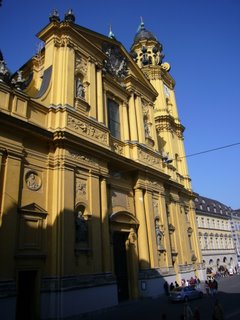
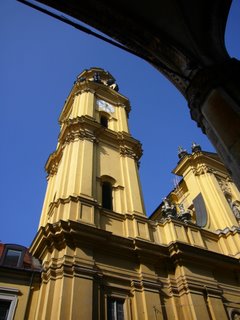
After that we went to a plaza, but again I was not able to understand the tour guide completely. It also didn't help that I was busy taking pictures.
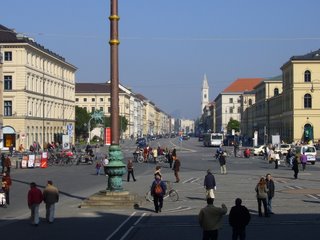
Nearby was another section of pedestrian street. Munich was the first city in Germany to create pedestrian only districts. The one car you can see in the photo is a typical German police car. Green is the color for police in Germany, not blue. Most of the police cars I have seen so far are BMWs and Audis, as were many of the local taxis in Munich.
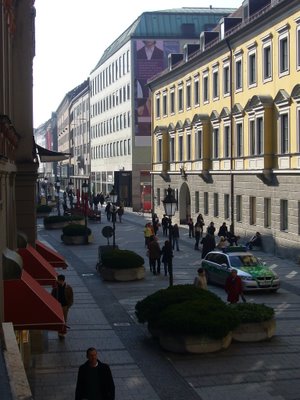
The next stop was the Hofbraeuhaus, the largest and most famous beer hall in Munich. I came here last time I was in the city, but one can never grow tired of it. Think of the stereotypical German beerhall, complete with men in liederhosen holding giant mugs of alcohol, and you have yourself the Hofbraeuhaus.

Our tour ended in the Marienplatz, which lies in front of the town hall, which is a beautiful structure of gothic design. The dark green looking area in the center of the tower is the Glockenspiel, which is a sophisticated clock built with moving figures depicting a medieval jousting tournament. I believe the Glockenspiel was built a little after the plague swept Europe.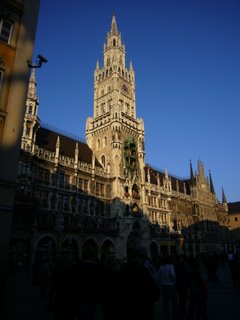
 Once the tour ended we split up for lunch. My group went to the oldest restaurant in Munich still in operation, Augustines, which also happens to specilaize in Bavarian cusine. Chris, the other American guy new to Eichstaett, ordered weinerwurst with potato salad on the side.
Once the tour ended we split up for lunch. My group went to the oldest restaurant in Munich still in operation, Augustines, which also happens to specilaize in Bavarian cusine. Chris, the other American guy new to Eichstaett, ordered weinerwurst with potato salad on the side.

Olga, a Spanish girl, (She swears there's not too many Olgas in Spain) and I got two orders of weisswursts, a local speciality. One can translate weisswursts to white sausage, which, as the following photo attests, is a very appropriate name. Keep in mind that the Japanese are know for the beautiful presentation of their food and meals, not the Germans.
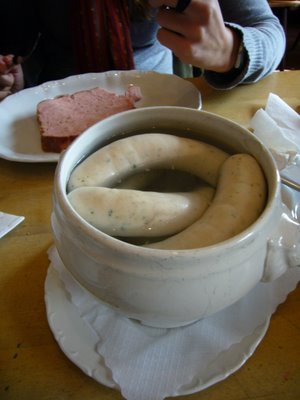
Despite looks, the taste was excellent. Apparently the skin on weisswursts is not meant for consumption, but I didn't learn that until I was on the last fourth of my serving. Though I think that that's more for taste reasons, not health. The chunk of meat in the background is leberkaese, basically a slab of ground sausage, that was ordered by another one of the Spanish girls.
Our time spent at Augustines was very rushed. The trip planners set our appointments without any flexibility and we were behind schedule. Our waitress was not too pleased with our reqeust for a quick service. She refused to split our check and that slowed us down a little more; the majority of the people in the group are only language students, so math skills are a little rusty.
Another memory from Augustines, German restaurants charge for the bread and pretzels brought to the table. One must keep track of how many pieces he eats and pay for them with the rest of the meal. If I had only remembered that while I was enjoying those salty twists of dough dabbed with sweet mustard.
With lunch out of the way we rushed off to meet the other students and arrive as close to time as possible for our tour at the Neue Pinakothek, one of the many art musuems in Munich. Now I enjoy art, but an art museum tour, particularly one led, for some reason, in German, is sometimes a tad boring for me. I'm much more of a go where I want at my own pace kind of guy. I tried so hard to pay attention for the first half of the tour, but then for the second half we entered the modern wing of the museum. I could express an interest in the tour a lot easier when I find myself face-to-canvass with works of art I had previously seen in text books. Works by such artists as Van Gogh . . .

Monet . . . 
Manet (who depicts his friend Monet in this painting). . . 
and others like Degas and Renoir.
After the Neue Pinakothek we took the subway back into city center. This is Chris and Ilania as they wait for the subway train to arrive. As said earlier, Chris is the other American guy new to Eichstaett this semester. I've met two other American guys who have returned to Eichstaett for their master's work after first studying abroad here during their bachlor's program. Chris is actually here to work as teacher's assistant for a semester or two, and will teacher a few English classes. He started studying German this summer, and is understandably with a little hesitation to teach here. Ilania comes from southern Italy and has to be one of the most cheerful persons I have ever met.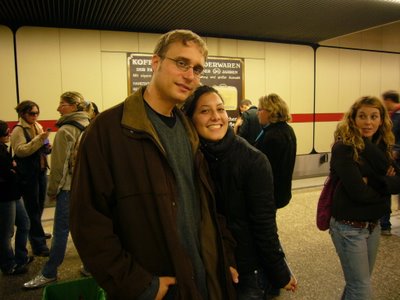
I have begun to notice a couple of universal constants while in Germany. One of which is that the smell of subway stations is the same around the globe.
After getting back into the city center we had some freetime to wander around Munich. Chris and I headed back to the Hofbraeuhaus so he could get a souvenir. We would have also ordered something to eat but a server never came to our table even though the staff said they would. Eventually we had to leave to meet up with the others at the train station. At this point in the evening my cold was attacking me head on, so rushing back to the train station was none too fun for me. A cup of tea ordered to go did help a little bit though.
Once on the train I tried to rest, but crazy Italian and Spanish girls kept me awake. Maria Rosa from Italy is only left. To the right of her is Elenea from Spain.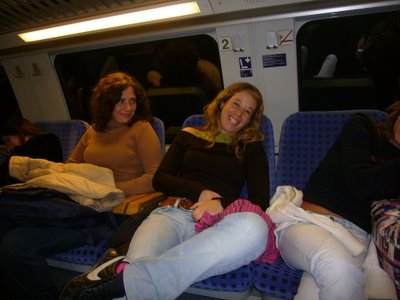
And Olga, who as mentioned earlier is also from Spain.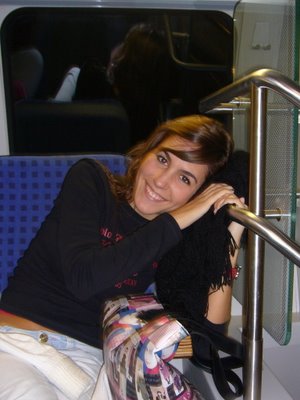
Overall the trip could have been a little better if I had not been sick, but it was still fun. I highly recommend a visit to Munich, it's a very friendly and welcoming city. As its offical tourist slogan posted in so many places around town says, Munich loves you.
1 comment:
Thanks for including pictures. These are really good snap shots of German life. I agree with Frau Penrod, send a shot with you in it every once in awhile. The Hofbraeuhaus is a beautiful building. Who would have thought a beer house would look so majestic?
Post a Comment